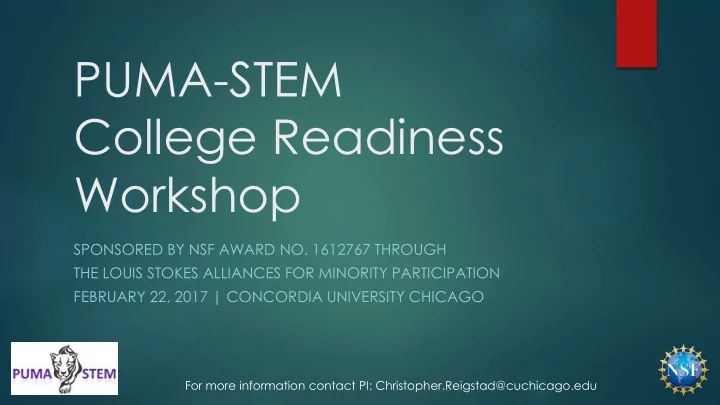

PUMA-STEM College Readiness Workshop SPONSORED BY NSF AWARD NO. 1612767 THROUGH THE LOUIS STOKES ALLIANCES FOR MINORITY PARTICIPATION FEBRUARY 22, 2017 | CONCORDIA UNIVERSITY CHICAGO For more information contact PI: Christopher.Reigstad@cuchicago.edu
What is PUMA-STEM? PUMA-STEM stands for Promotion of Underrepresented Minorities in Academic STEM* PUMA-STEM is a collaboration among regional high schools and colleges to increase graduation rates and career success of underrepresented minorities (URMs) in STEM; NSF defines URMs in STEM as including African-American, Hispanic, American Indian, Alaskan Native, and Pacific Islander Funded in September of 2016 by a Pre-Alliance Planning Grant from the NSF (National Science Foundation) and the LSAMP (Louis Stokes Alliances for Minority Participation) The funded grant is sponsoring workshops and research to improve success of URMs in STEM regionally, with broader impact envisioned through expansion of meaningful academic networks and collaborations with STEM business and industry *STEM = Science, Technology, Engineering, and Mathematics
Persistence in STEM: A “pervasive pattern” according to the Joint Working Group on Improving URMs Persistence in STEM (convened by the National Institute of General Medical Sciences and the Howard Hughes Medical Institute): URM students plan to undertake STEM majors in college at the same rate as do white students but do not graduate with STEM degrees at the same rate Sources: Hurado, et al., 2009; Presidential Council of Advisors on Science and Technology [PCAST], 2012.
Related Findings A 2012 survey of 22-to 24-year-old U.S. citizens showed that 38% of Asians and 22% of Whites had completed at least a bachelor’s degree; however, this could only be said for 12% of Blacks and 11% of Hispanics (Fry & Taylor, 2013). STEM attrition occurs more frequently among students with weaker academic backgrounds (Astin & Astin 1992; Mendez, Buskirk, Lohr & Haag, 2008; Shaw & Barbuti 2010; Whalen & Shelley 2010). Robust high school STEM curricula, including advanced mathematics, greatly increase the chances that low-income and first-generation students will attend college, particularly four year institutions (Choy, 2001; Horn & Nunez, 2000). However, sending first generation students, many of whom are from minority groups, into advanced coursework without adequate support is a set up to failure (Engle & Tinto, 2008).
PUMA-STEM PIs and Personnel: Left to Right: Charles Zona (Hooke College of Applied Sciences), Matt Kirkpatrick (Oak Park and River Forest High School), Christopher Reigstad (Concordia University Chicago (CUC)), Amy Paulus (Proviso Math and Science Academy), Victor Govindaswamy (CUC), Eve Mellgren (Elmhurst College), Christopher Anderson (Dominican University)
Workshop Goals: 1. Increase awareness of college readiness barriers faced by underrepresented minority (URM) students 2. Identify the most significant barriers for URMs related to success in STEM 3. Discuss and develop strategies to overcome these barriers
Workshop Agenda/Timeline: 4:30-4:45 Introduction 4:45-5:30 Address discussion questions (groups of approx. 4) 5:30-5:50 Report back to entire group 5:50-6:20 Discuss findings and possible solutions and improvements 6:20-6:30 Wrap-up and next steps
Recommend
More recommend